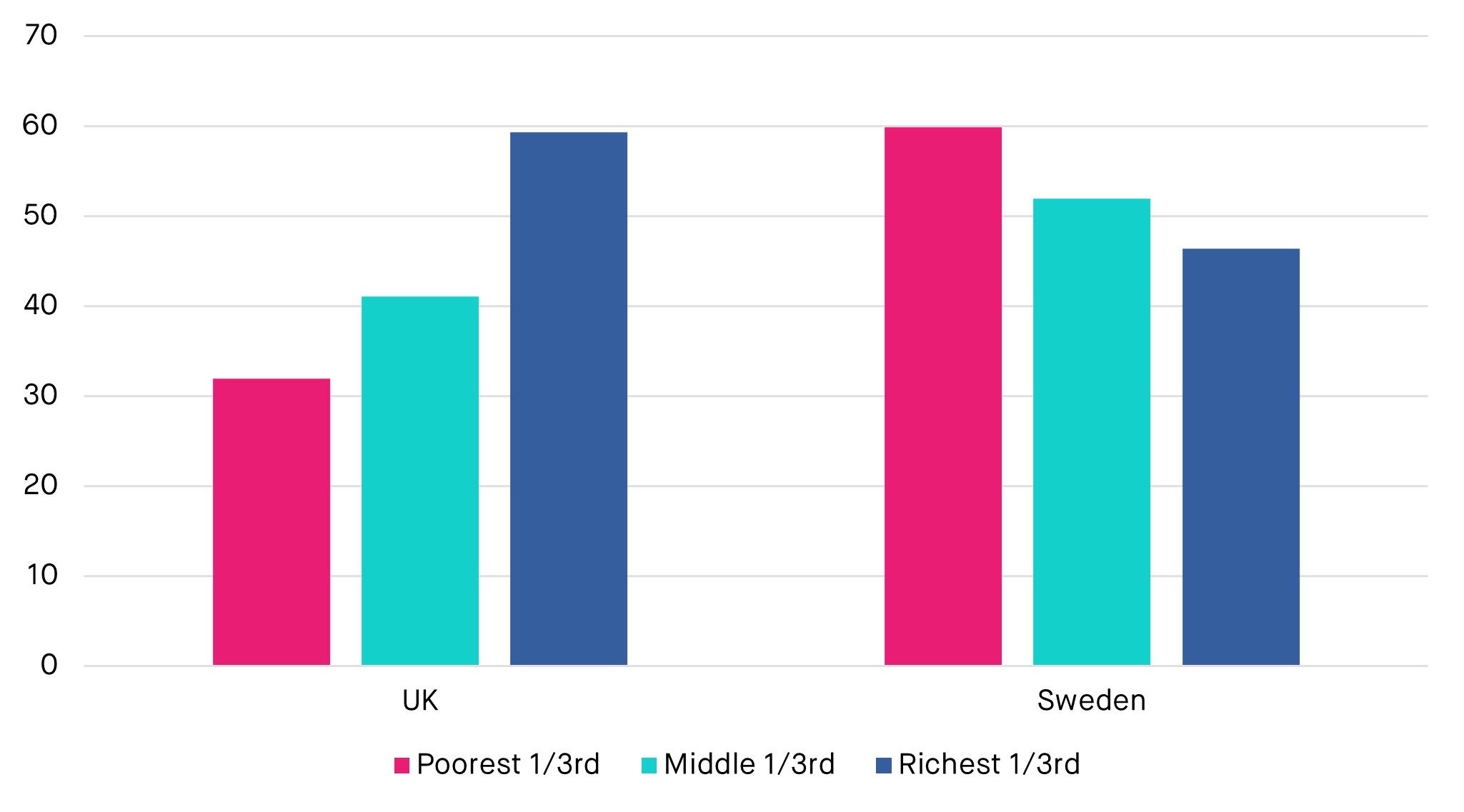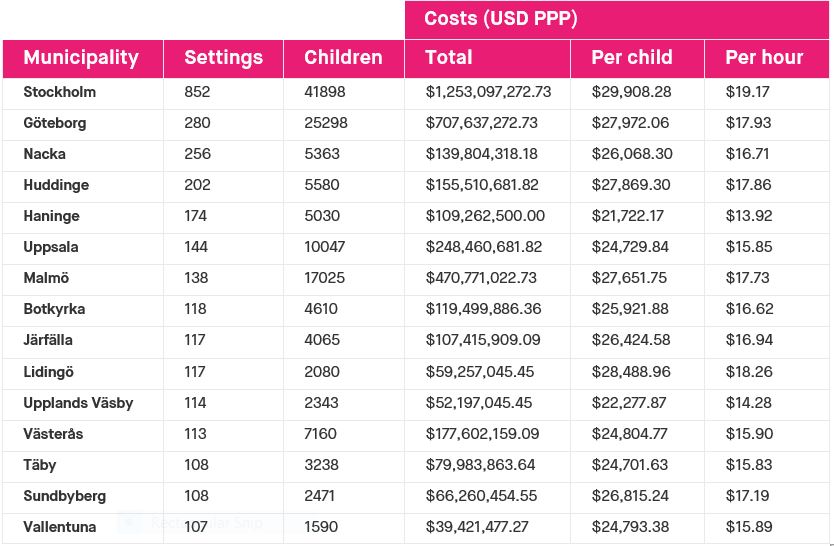The answer lies not just in comparing the costs to parents, but also the societal costs of providing childcare - which are surprisingly difficult to work out, requiring bottom-up data gathering and calculations. In this blog, SMF's Hari Menon compares the cost of provision between UK and Sweden, to open up the discussion on childcare accessibility.
Childcare in the UK
British childcare costs, we are regularly told, are some of the highest in the world, with a commonly quoted figure being 25% of income after benefits. According to the OECD, that represents the net cost to a couple earning 67% of the average wage of keeping a two year old and a three year old in full-time childcare. An even more headline grabbing figure is the over 70% of weekly take-home pay that some parents in inner London have to spend on childcare. Statistics abound, but the bottom line remains largely the same: our childcare is very expensive.
Yet there is a paradox: while parents feel like they are paying exorbitant fees, nurseries are struggling to make enough money to keep the doors open. The National Day Nurseries Association has found that for each child that is promised 15 hours of free childcare a week, the average nursery is underfunded by £2.31 per hour (or £1,317 per year). While the Spring 2024 Budget promised to improve this situation, “for some nurseries who have already closed, it’s too late” says Purnima Tanuku OBE, Chief Executive of the NDNA.
Childcare in Sweden
In Sweden, the same OECD data puts the net cost of childcare for a similar family at 5% of income, a fifth as much as the UK. With the government placing a cap on per-child expenses at 3% of income (with progressively lower limits for subsequent children), the numbers don’t change dramatically for different family types. The Swedish childcare system, which is predominantly publicly run, is the poster-child of high-quality and affordable childcare.
In almost all other OECD countries, enrolment rates in childcare centres are highest for the wealthiest income groups. The effect of Sweden’s progressive subsidy for childcare is that enrolment rates in Sweden bucks this trend. 60% of children from the poorest third of families enrol in childcare centres, compared to 46% of children from the richest third. Meanwhile in the UK, the enrolment rate is 32% for the poorest third and 59% for the richest.
Graph 1: Enrolment rates (%) in childcare by income level, 0-2 year olds

Source: OECD Family Database
Cost to provide vs Price to pay
From one perspective – the parents’ – it is clear that the British childcare system is extremely expensive, and the Swedish one much more affordable. But this is only one perspective. We should also care about the societal cost of childcare – the resources we as a society have to spend on childcare, both through parents’ out-of-pocket payments and government subsidy. Only by examining this full economic cost to provide childcare, rather than just looking at the price parents pay, can we tell whether British childcare is unusually inefficient – and so in need of supply-side reforms – or whether the problem is just that the state picks up too little of the tab.
The trouble is that while there is international comparable data on cost to parents and public subsidy, there isn’t anything that brings those together to tell us the full cost to provide childcare. In fact, it turns out to be surprisingly difficult to work out whether British childcare is more or less efficient than our international peers, requiring bottom-up data gathering and calculations.
To make a start on answering that question, we decided to compare the UK and Sweden, a country lauded for its apparently cheap childcare, making certain simplifying assumptions. The UK’s childcare system is privately run, hence information on its cost structure is at a company level. Since the childcare sector normally operates on thin margins, we assumed profits to be negligible and total costs to equal total revenues. These revenues would include the fees paid by parents and the grants given by the government. By taking a sample of companies, combined with their occupancy rate and number of settings, we determined the average cost to provide childcare services per setting, per child and per hour in a year, expressed in USD and adjusted for purchasing power.
Sweden’s system is publicly run by municipalities and their cost information is readily available. The total cost that each municipality incurs to provide childcare services can be combined with data on the enrolment rates and number of settings to determine the same comparable statistics as in the UK.
Before looking at the data, it is necessary to preface these results with a note of caution. This is a preliminary attempt to understand the cost of providing childcare and the data has been sourced from publicly available sites. It compares the UK to just one other country – Sweden, when there are many others we might wish to emulate (for example, France or Canada). The purpose of this piece is to open up the discussion on childcare accessibility to other possible avenues for improvement and further study, rather than draw definitive conclusions.
Costs in the UK
Data for the UK was taken primarily from five large childcare providers (refer to Table 1) representing more than 10% of the UK market.
Table 1: UK nursery providers’ revenues

Source: Data as of 2021 (2022*) taken from Nursery World and HMRC
A study of early years providers in 2020 found that the industry’s occupancy rates hovered between 75% to 85%, and so we assumed that 80% of provided places were filled. A study by the Department of Education yielded an average of 23 hours of childcare per week for all children aged 0-4. Armed with these assumptions, and taking the total revenues and places of the sample companies, we found that providers incur an average annual cost of:
- USD PPP $1,176,458 per setting / £823,520
- USD PPP $15,721 per child / £11,004
- USD PPP $13.14 per hour / £9.20
These results are roughly in line with the average hourly fees paid by parents, which were between £5.60 – £5.72 in 2022, as well as government funding which averaged between £5.00 – £5.62 in 2022 per hour, producing a slightly higher figure of £10-11.
Costs in Sweden
Table 2: Sweden childcare provider costs

Source: Data as of 2021 taken from Swedish Statistical Database
Swedish data was taken from the municipality finance data. Each municipality includes reports on the total cost of childcare services (including payments made to independent providers). These costs are eventually offset by federal grants and parent fees making the net cost to the municipality much lower. The total cost data can be paired with data on the number of childcare settings and enrolments across different age groups (1-5). Since Swedish parents receive over a year of paid parental leave, they seldom send their children to childcare centres before they turn one. Swedish children spend about 30 hours a week in childcare. Taking data from the 15 municipalities in Sweden with the largest number of childcare settings shows that municipalities incur an average annual cost of:
- USD PPP $1,151,209 per setting
- USD PPP $26,010 per child
- USD PPP $16.67 per hour
Comparing costs
Table 3: UK and Sweden cost comparisons (USD PPP)

While the cost per setting is broadly similar in both countries, cost per child and per hour are noticeably different. These results imply that:
- Nursery settings in the UK cater to more children than in Sweden. This does not necessarily mean overcrowding, as the UK has regulations in place about the amount of space each child needs and the ratio of child to staff.
- The difference in the cost per child is partially offset by the increased hours of childcare in Sweden, but overall it seems that childcare in the UK is actually cheaper to provide than in Sweden.
Since the Swedish system scales the cost of childcare with income and places a cap on total monthly fees, parents can send their children to childcare centres for as long as they want. 30 hours a week of childcare is almost equivalent to a typical workday and allows both parents to work almost full time if they choose. The UK’s system of 15 free hours of childcare almost guarantees that one parent has to sacrifice a full time job to care for the child during the week, or equal the government’s contribution in extra hours of childcare. There is hope that this will improve in time with the announcement during the Spring Budget of 30 hours of free childcare, for children aged 9 months and up by 2025.
If childcare is indeed cheaper in the UK than it is in Sweden, then the government will have a comparably easier time funding an expanded childcare system here than in Sweden.
Conclusion
It is widely believed that British childcare is expensive, and Swedish childcare is cheap. Certainly, this is so from the parents’ perspective. Yet our analysis suggests that the cost of providing childcare, the cost to society, appears to be lower in the UK. The big difference between the two countries is that much more of the cost is borne by the state in Sweden. It is also worth noting, however, that Sweden’s tax to GDP ratio is a third higher than the UK’s and hence the government has more resources available to expend on childcare subsidies.
These findings seem to imply that the UK’s decision to privatise childcare services has the benefit of keeping production costs low, though it does so while heaping pressure on providers. While those on the right see deregulation as necessary for fixing the country’s childcare problems, it may well be that regulation is necessary to keep cost-cutting measures in check without compromising the quality of childcare services. Additionally, nursery workers are paid roughly equivalent salaries in both countries. The UK’s nursery settings appear better optimised to cater to more children in each setting, while keeping within the EYFS Statutory Framework’s requirements on space and staffing. In the end, based at least on comparison with Sweden, it is hard to avoid the conclusion that our childcare system is not unusually inefficient, but simply underfunded. That implies that the UK government needs to spend more on childcare, as it signalled it will in the most recent Budget.
